 Miscellaneous
Miscellaneous  Miscellaneous
Miscellaneous  Politics
Politics 10 Lesser-Known Far-Right Groups of the 21st Century
 History
History Ten Revealing Facts about Daily Domestic Life in the Old West
 Weird Stuff
Weird Stuff 10 Everyday Products Surprisingly Made by Inmates
 Movies and TV
Movies and TV 10 Actors Dragged out of Retirement for One Key Role
 Creepy
Creepy 10 Lesser-Known Shapeshifter Legends from Around the World
 Animals
Animals 10 Amazing Animal Tales from the Ancient World
 Gaming
Gaming 10 Game Characters Everyone Hated Playing
 Books
Books 10 Famous Writers Who Were Hypocritical
 Humans
Humans 10 of the World’s Toughest Puzzles Solved in Record Time
 Miscellaneous
Miscellaneous 10 Ironic News Stories Straight out of an Alanis Morissette Song
 Politics
Politics 10 Lesser-Known Far-Right Groups of the 21st Century
 History
History Ten Revealing Facts about Daily Domestic Life in the Old West
Who's Behind Listverse?

Jamie Frater
Head Editor
Jamie founded Listverse due to an insatiable desire to share fascinating, obscure, and bizarre facts. He has been a guest speaker on numerous national radio and television stations and is a five time published author.
More About Us Weird Stuff
Weird Stuff 10 Everyday Products Surprisingly Made by Inmates
 Movies and TV
Movies and TV 10 Actors Dragged out of Retirement for One Key Role
 Creepy
Creepy 10 Lesser-Known Shapeshifter Legends from Around the World
 Animals
Animals 10 Amazing Animal Tales from the Ancient World
 Gaming
Gaming 10 Game Characters Everyone Hated Playing
 Books
Books 10 Famous Writers Who Were Hypocritical
 Humans
Humans 10 of the World’s Toughest Puzzles Solved in Record Time
10 Great Buildings That Were Not Built Quite Well Enough
Architects aren’t perfect, and even the best-laid buildings can go awry. Here are 10 building, statues, towers, and bridges from both ancient and modern history, and how they met their untimely demises.
10The Temple Of Artemis At Ephesus
Ephesus, Turkey
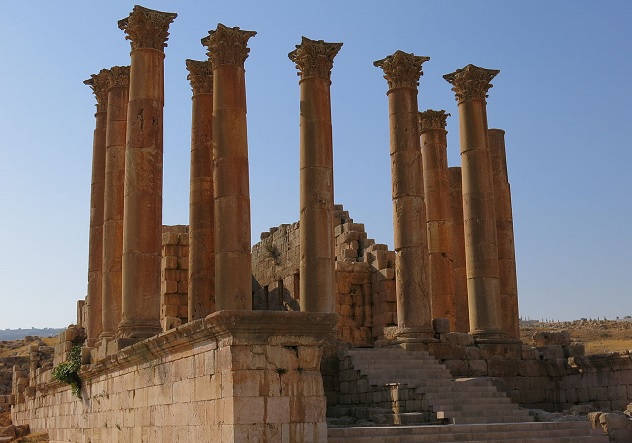
The Temple of Artemis, located in Ephesus, Turkey (now called Selcuk) was built three times in antiquity. The first iteration was built in the eighth century B.C. by unknown architects. This temple had a hard clay floor, but in the next century, a flood deposited a couple feet of sand and debris inside the temple, forcing its abandonment.
Around 550 B.C., architects Chersiphron and his son Metagenes began rebuilding the temple. The plan was for it to be about 115 meters (377 ft) long and 45 meters (150 ft) wide, with a double peripteral colonnade about 12 meters (40 ft) high. This formed a passageway around the central statue of the goddess Artemis. Pliny the Elder stated that 36 of these columns featured beautifully elaborate carvings.
This construction is said to have lasted 120–200 years. The roof was made of wood however, which proved its downfall. An idiot named Herostratus decided he would make himself famous by burning the temple to the ground. So on July 21, 356 B.C., he did just that. He then proudly claimed responsibility and was executed on order of Ephesian authorities.
Construction on the third and final iteration began in 323 B.C. and continued for an indefinite number of years. This would be the grandest of the three temples: 137 meters (450 ft) long, 68 meters (225 ft) wide, and 18 meters (60 ft) high, with over 127 columns. This version lasted until A.D. 262, when an East Germanic Goth tribe crossed the Hellespont and raided Asia Minor. During their sacking, pillaging, and city-razing spree, they did not spare the Temple.
9The Mausoleum At Halicarnassus
Turkey
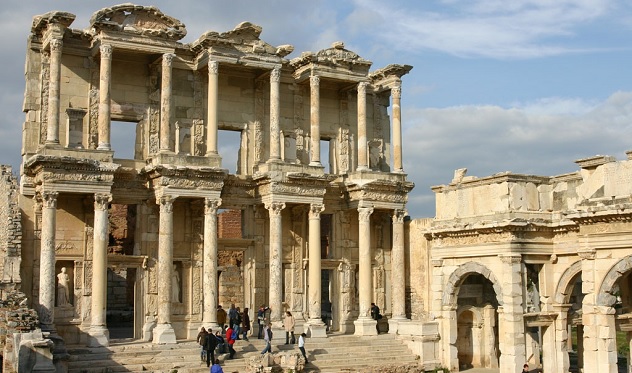
This Wonder of the Ancient World was built at Halicarnassus, Turkey (present-day Bodrum) for Persian provincial governor Mausolus and his wife, Artemisia II. It was built in just three years (353–350 B.C.), which is an extremely short period for the methods of antiquity and was the second-longest standing Ancient Wonder out of the Seven. Only the Great Pyramid, which still stands today, outlasted it.
The Mausoleum was constructed inside a stone courtyard on a giant stone base 19 meters (63 ft) long. Its perimeter was 125 meters (410 ft) around, and the distance from the bottom to the top of the tomb measured 11 meters (38 ft). The tomb sat on its own base, and atop it was set a marble pyramid with 24 steps. This brought the structure’s total height to about 45 meters (150 ft).
The Mausoleum also featured 36 marble columns, with lions 1.5 meters (5 ft) tall carved from solid marble between them. Other statues featured scenes from Greek mythology and history. The pinnacle of the pyramid was left flat and a huge bronze chariot with four marble horses adorned it, with the statues of Mausolus and Artemisia standing in the chariot.
A structure this massive, with a wide base founded on solid rock and made entirely of marble, was destined to last a long time. Even when Alexander the Great sacked Halicarnassus in 334, the Mausoleum was undamaged. Three hundred years later, pirates invaded the city and caused widespread destruction, but again the Mausoleum escaped unscathed.
Earthquakes finally began to bring it down in 1304. By 1404, only the base was recognizable. In 1522, Crusaders finally dismantled what was left of the Mausoleum’s ruins, building a fort in its place.
8The Maccabiah Bridge
Tel Aviv, Israel
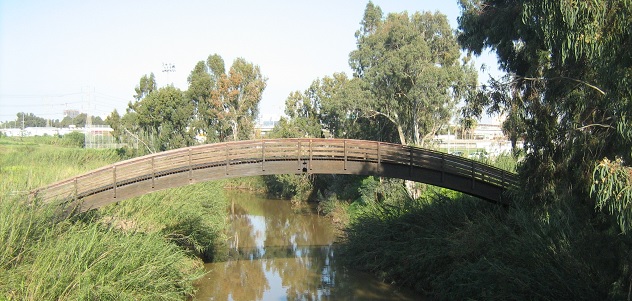
On July 14, 1997, during the opening parade of the Maccabiah Games, an Australian team of athletes was walking across the wooden Maccabiah Bridge. Suddenly, the bridge snapped right through at the middle, sending 100 people plummeting into the water.
Only one person, Gregory Small, was killed due to the actual collapse, but three more died at the hospital due to fast pulmonary infections caused by a dangerous fungus in the water. Known as Pseudallescheria boydii, this fungus infects the lungs of its victims and then spreads to the heart, kidneys, brain, and thyroid.
The three victims were autopsied, and doctors identified the problem just in time to save 15-year-old Sasha Elterman. The fungus had left her in critical condition, but she survived after 18 surgeries (13 of which focused on the brain). Her lungs lost 40 percent of their capacity, and she stills suffers convulsions. All this because the wooden bridge could not support the weight of 100 people.
7The Rialto Bridge
Venice, Italy
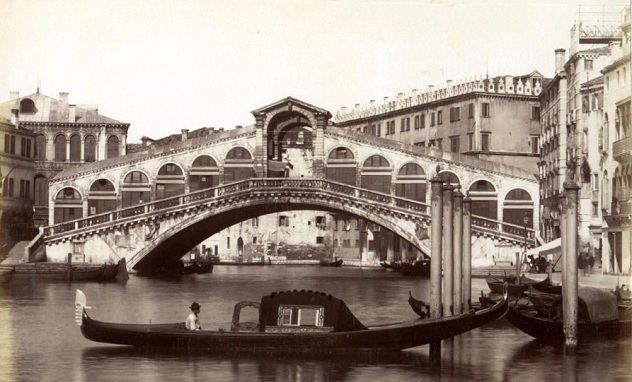
The Rialto is the oldest bridge in the Venetian canal system. It was originally constructed as a pontoon bridge in 1181. In 1255, it was replaced by a permanent wooden bridge with a distinctive triangular arch shape. This new bridge featured two wooden ramps and a movable central section where they met, which allowed for large boats to pass. In the early 1400s, rows of shops were opened along the marketside, the rent money from which enabled the bridge to remain well maintained.
Unfortunately, as strong as wood can be, it degrades quickly when compared to stone or steel. In addition, the bridge suffered fire damage during the 1310 revolt of Bajamonte Tiepolo. In 1444, it collapsed into the canal under the weight of a throng of people watching a boat parade.
After that disaster, the Venice City Council finally decided to pay for its reconstruction in stone. The reconstruction project took three years, from 1588 to 1591. This bridge is the one which still spans the canal today.
6The Colossus Of Rhodes
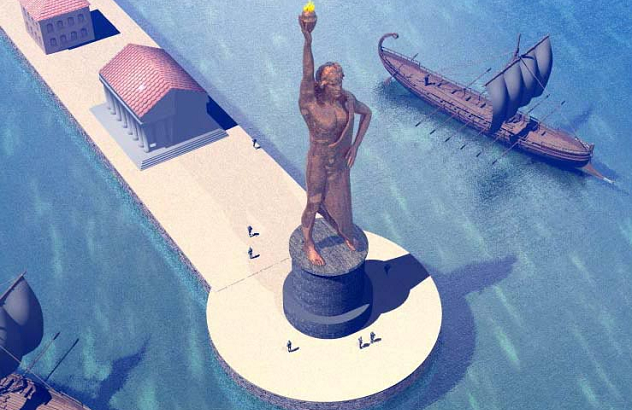
In 280 B.C., Chares of Lindos designed and erected the Colossus of Rhodes to commemorate the island of Rhodes’s victory over Antigonus I Monophthalmus. The statue was of the Greek sun god Helios, and stood some 33 meters (110 ft) tall, not counting the 15-meter (50 ft) white marble pedestal on which it stood.
The Colossus was built out of a skeleton of iron beam, with skin made out of welded-on bronze plates. Since the statue itself was hollow, workers inserted stone columns inside for stability.
There was, for a long time, a heated debate among historians about whether the statue straddled the harbor as depicted in many illustrations, or stood on one side only. Today, we know that it would have been in the traditional Greek pose for statues: legs together, nude or semi-nude, and with a cloak over the left arm or shoulder, similar to the toga pose. This pose would have required it to have been built on only one side of the harbor.
As sturdy as the Colossus was, it did not survive the Rhodian earthquake of 226 B.C. The Colossus fell apart piece by piece as the weakest links—the rivets holding the bronze plates together—snapped through. Eventually, the whole statue plunged into the sea.
5The Leaning Tower Of Zaragoza
Zaragoza, Spain

Th Leaning Tower of Zaragoza was built between 1504 and 1512, at the Plaza de San Felipe in Spain. While comprised entirely of brick, it was apparently not founded properly at all. Shortly after construction, it began to lean just like the Tower of Pisa. Unlike Pisa though, which survives to this day as an immensely popular tourist attracttion, Zaragoza’s lean alarmed the City Council, which in 1894 voted to have it demolished.
One additional reason for the tower’s excess lean is that starting in 1508, it served as a public clocktower. Its huge bells, when they swung to chime the hours, did absolutely no good for its posture. The tower eventually tilted a full 3 meters (10 ft) from its axis, more than enough to endanger the people below and force its closure and eventual destruction.
4The Belltower Of St. Mark’s Basilica
Venice, Italy
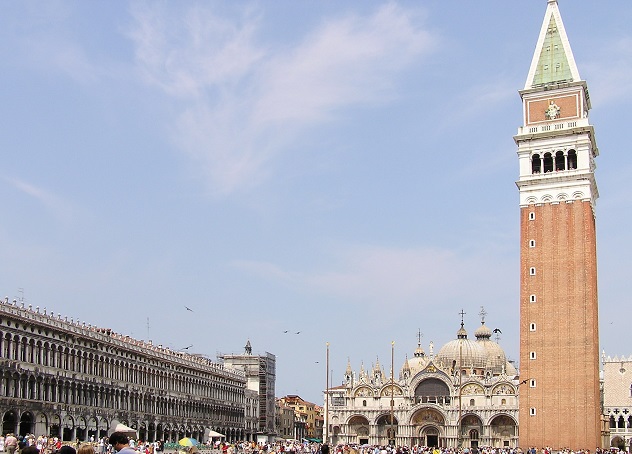
The St. Mark’s Basilica Belltower that stands today is actually a reconstruction of the original. The first version underwent construction in the ninth century A.D., on a site of Roman foundation stone. It was completed sometime in the 12th century.
The original tower consisted of simple brick and mortar with some wood. A fire in 1489 burned off the spire, and a 1511 earthquake further damaged the tower. It was repaired several times—after a period of restoration completed in 1513, it started taking the shape by which it is known today. Architects added a marble belfry at this time, along with an attic featuring a sculpture of a lion in tribute to Saint Mark. The spire was gilded, and a wooden statue of the Archangel Gabriel fixed to the pinnacle.
On July 14, 1902, the entire tower collapsed into a huge heap of rubble at 9:45 in the morning. No people were killed, fortunately, and the surrounding structures suffered very little damage. That night, the City Council approved its immediate rebuilding, and it was restored precisely as it had appeared, though now reinforced on the inside. The new tower, which still stands today, was inaugurated on April 25, 1912.
3The Imperial Library Of Constantinople
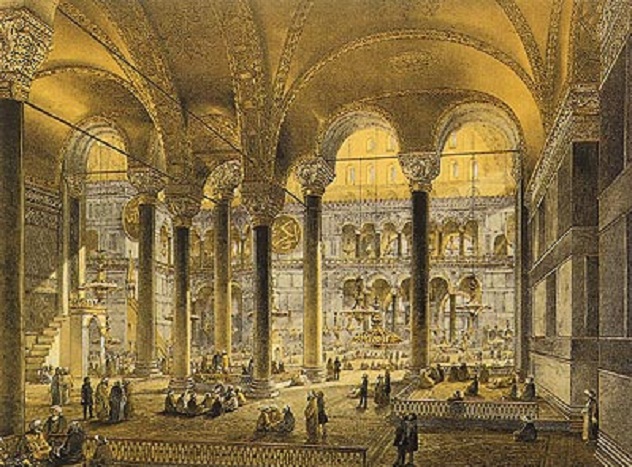
The ancient world had many a great library, the last of which was the Imperial Library of Constantinople (now Istanbul, though that’s nobody’s business but the Turks). It was founded around A.D. 350, under the reign of Emperor Constantius II, who hired the great architect Themistios to both design and stock the building.
When choosing what to preserve from ancient history, Themistios and his team honed in on classical Latin and Greek literature. Much of this was rapidly crumbling on old paper and papyrus, so Themistios and his team had to transcribe them onto parchment, which lasted much longer and is the reason much of that classical text survives to this day.
It certainly wasn’t due to the library itself, which suffered several fires over the centuries. Its most notable burn came in A.D. 473, when over 120,000 volumes were destroyed. Nevertheless, the building stood until 1453, when Constantinople fell to the Ottoman Empire. The library was destroyed, taking all but a few pieces of literature with it.
2Tre Kronor Castle
Stockholm, Sweden

The Tre Kronor (Three Crowns) Castle stood on the same grounds as present-day Stockholm Palace. We know very little about Kronor Castle’s history though, because the Swedish national library and royal archives were housed entirely inside the castle, which burned to the ground on May 7, 1697.
We do know that the castle consisted of an inner keep surrounded by walled gardens, with the keep constructed of wood and copper. It was thus not as fireproof as stone, so when a fire began in the attic at about 2:00 PM, it spread very quickly.
There were three fire marshals on duty: Sven Lindberg, Anders Andersson, and Mattias Hansson. Lindberg briefly attempted to fight the fire, but testified that it blocked his access to the firefighting equipment. The heat melted the copper plates of the ceiling, which set the roof on fire. When it finally collapsed, it brought most of the walls with it.
The royal family and court were evacuated, and the three firemen tried and convicted of failing to save the castle. Lindberg and Hansson were sentenced to death, while Andersson was forced to run the gauntlet (passing through a long line of soldiers attempting to beat you to death with clubs and other weaponry) five times. The two death sentences were later commuted to seven gauntlets, though Lindberg died in the middle of his barbaric punishment.
1The Lighthouse Of Pharos Island
Alexandria, Egypt
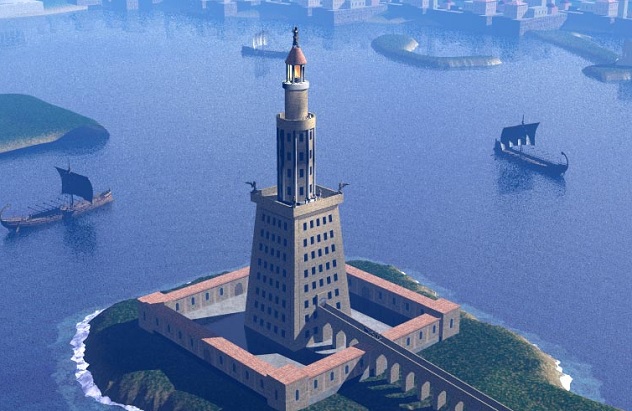
Another one of the Seven Wonders of the Ancient World, construction began on the lighthouse around 280 B.C. and lasted until 247 B.C. The finished structure reached a height of 120–137 meters (393–450 ft), making it second only to the Great Pyramid of Giza on the list of tallest man-made structures of the time.
According to eyewitness accounts of the lighthouse, it was made out of monolithic limestone blocks. A mirror at the top reflected the sunlight during the day, and the light of a furnace built in front of it during the night. It was comprised of three stages: a rectangular base with an octagonal core, a secondary continuation of this octagon, and a cylindrical stage featuring the mirror and furnace.
That the lighthouse went undamaged for some 1,200 years—in an earthquake-prone region no less—is especially impressive. Its lantern fell out of the top in the eighth century A.D., though, and an earthquake in 956 meant the beginning of the end for the lighthouse’s good luck. Arabian conquerors repaired it, but when the 1303 Cretan Earthquake struck, the lighthouse finally toppled. Twenty years later, a third earthquake completed the lighthouse’s destruction, rendering it a huge pile of limestone blocks.
In a way though, the Lighthouse lives on. In 1480, the surviving rubble was used by Al-Ashraf Sayf ad-Din Qa’it Bay, Sultan of Egypt, to construct his Citadel. Over 530 years later, that Citadel still stands.
FlameHorse is a writer for Listverse.








